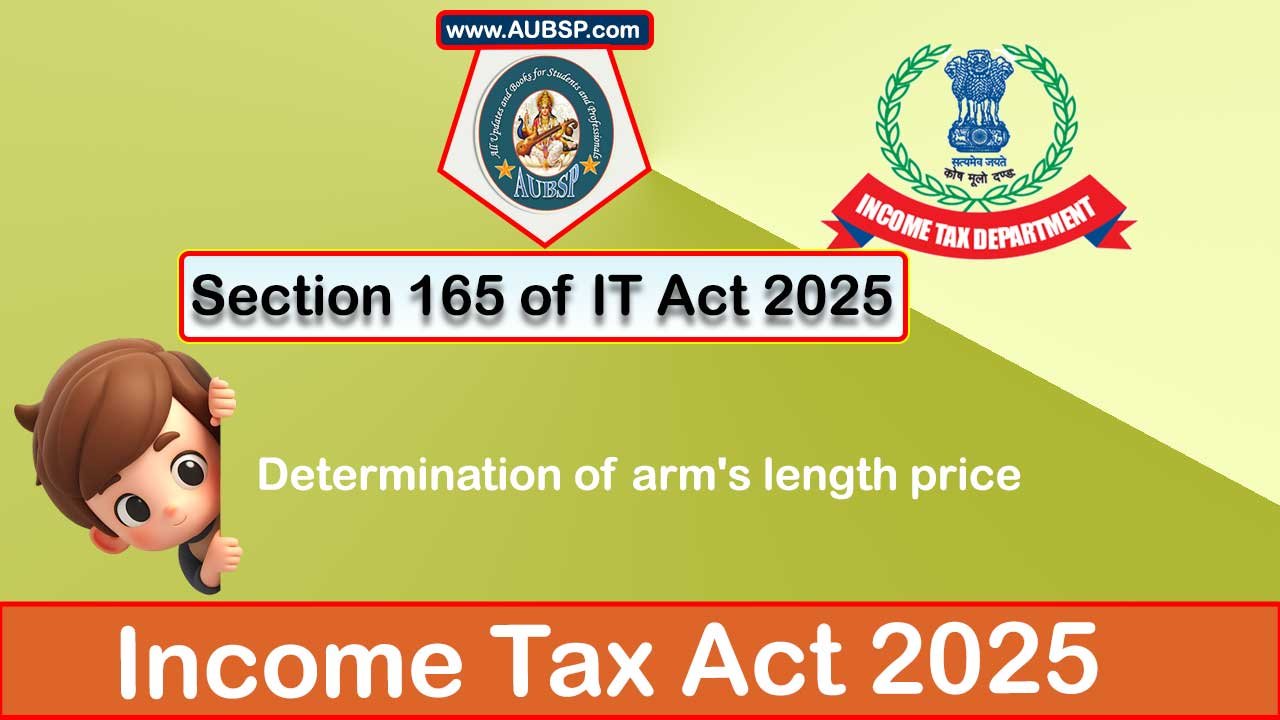Determination of arm’s length price
[Section-165 as per the Income Tax Act, 2025 (this Act) w.e.f. 1st April, 2026.]
Section 165(1) of Income Tax Act 2025
165(1) The arm’s length price in relation to an international transaction or specified domestic transaction shall be determined by any of the following methods, being the most appropriate method––
- (a) comparable uncontrolled price method;
- (b) resale price method;
- (c) cost plus method;
- (d) profit split method;
- (e) transactional net margin method;
- (f) such other method as prescribed by the Board.
Section 165(2) of Income Tax Act 2025
165(2) The most appropriate method referred to in sub-section (1) shall be,––
- (a) selected having regard to the nature of transaction or class of transaction or class of associated enterprise or functions performed by such enterprises or such other relevant factors as the Board may prescribe;
- (b) applied for determination of arm’s length price in such manner as prescribed.
Section 165(3) of Income Tax Act 2025
165(3) The arm’s length price shall be—
- (a) in case, only one price is determined by the most appropriate method,––
- (i) the price determined by that method; or
- (ii) the price at which the international transaction or specified domestic transaction has actually been undertaken, if the variation between the arm’s length price so determined and price at which the international transaction or specified domestic transaction has actually been undertaken does not exceed such percentage not exceeding 3% of the latter, notified by the Central Government in this behalf; or
- (b) in case, more than one price is determined by the most appropriate method, the price determined in such manner as prescribed.
Section 165(4) of Income Tax Act 2025
165(4) The Assessing Officer, during the course of any proceeding for the assessment of income, may proceed to determine the arm’s length price in relation to an international transaction or specified domestic transaction as per sub-sections (1), (2) and (3) if, on the basis of material or information or document in his possession, he is of the opinion that—
- (a) the price charged or paid in an international transaction or specified domestic transaction has not been determined as per sub-sections (1), (2) and (3); or
- (b) any information and document relating to an international transaction or specified domestic transaction has not been kept and maintained by the assessee as per section 168(1); or
- (c) the information or data used in determination of the arm’s length price by the assessee is not reliable or correct; or
- (d) the assessee has failed to furnish, within the specified time, any information or document which he was required to furnish by a notice issued under section 171(2).
Section 165(5) of Income Tax Act 2025
165(5) The Assessing Officer, before determining the arm’s length price under sub-section (4), shall give a notice calling upon the assessee to show cause, on the date and time to be specified in the notice, why the arm’s length price should not be determined on the basis of material or information or document in his possession.
Section 165(6) of Income Tax Act 2025
165(6) The Assessing Officer, on determination of arm’s length price under sub-section (4), may compute the total income of the assessee having regard to the arm’s length price so determined.
Section 165(7) of Income Tax Act 2025
165(7) No deduction shall be allowed under section 144 or under Chapter VIII in respect of income by which the total income of the assessee is enhanced after computation of income under sub-section (6).
Section 165(8) of Income Tax Act 2025
165(8) When the total income of an associated enterprise is computed under sub-section (6) on determination of the arm’s length price paid to another associated enterprise from which tax has been deducted or was deductible under the provisions of Chapter XIX-B, the income of the other associated enterprise shall not be recomputed by reason of such determination of arm’s length price in the case of the first mentioned enterprise.
FAQs on Section 165 of Income Tax Act 2025
What is the arm’s length price in the context of international or specified domestic transactions?
Arm’s length price is the price applied or proposed to be applied in a transaction between unrelated parties under uncontrolled conditions.
How is the arm’s length price determined under Section 165(1)?
The arm’s length price is determined by the most appropriate method from the following: comparable uncontrolled price method, resale price method, cost plus method, profit split method, transactional net margin method, or any other method as prescribed by the Board.
What factors are considered in selecting the most appropriate method?
The selection is based on the nature of the transaction, class of transaction, class of associated enterprise, functions performed, or any other relevant factors prescribed by the Board.
How is the most appropriate method applied?
The method must be applied in the manner as prescribed by the Board for determining the arm’s length price.
What happens if only one price is determined by the most appropriate method?
That price is considered the arm’s length price, unless the actual transaction price does not exceed the allowed variation (up to 3%) notified by the Central Government, in which case the actual price is accepted.
What if more than one price is determined using the most appropriate method?
In such cases, the arm’s length price is determined in a prescribed manner from among the multiple prices.
Can the Assessing Officer reject the assessee’s determination of arm’s length price?
Yes, under Section 165(4), the Assessing Officer can reject it if the price was not determined per legal provisions, or if required documentation is missing, unreliable, or not furnished in time.
What action does the Assessing Officer take before determining a different arm’s length price?
The Assessing Officer must issue a notice to the assessee to show cause why the price should not be redetermined based on the material in his possession.
What follows once the Assessing Officer determines a new arm’s length price?
The total income of the assessee is recomputed having regard to the newly determined arm’s length price.
Is any deduction allowed on the enhanced income after such recomputation?
No, deductions under section 144 or Chapter VIII are not allowed on the enhanced income arising from recomputation.
If arm’s length price adjustment affects one associated enterprise, is the other associated enterprise’s income recomputed?
No, if tax has been deducted or was deductible from the payment, the other associated enterprise’s income is not recomputed due to the adjustment.
What is the permitted variation between the actual transaction price and the determined arm’s length price?
A variation not exceeding 3% of the actual transaction price may be notified by the Central Government, within which the actual price may be accepted.
Who prescribes the application and selection rules for the most appropriate method?
The Central Board of Direct Taxes (Board) prescribes the rules under Section 165(2).
Is the arm’s length price determination applicable only to international transactions?
No, it applies to both international transactions and specified domestic transactions.
What documentation must the assessee maintain regarding arm’s length price determination?
The assessee must maintain documentation as specified in Section 168(1), including details supporting the chosen method and price determination.


